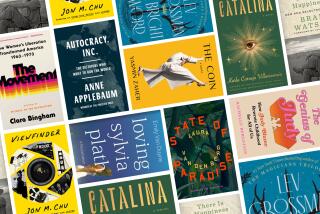Book review: ‘Hot Pink’ by Adam Levin
- Share via
Hot Pink
Adam Levin
McSweeney’s Books: 211 pp., $22
In the nine years it took Adam Levin to write his 1,030-page novel “The Instructions” (2010), he was also publishing short fiction. Those pieces, plus a few more, are gathered in the trim collection “Hot Pink,” proving that even with a tiny word count, Levin can tell a good, funny story.
This collection is front loaded: Its best pieces, surreal and sardonic, appear at the book’s beginning. First is “Frankenwittgenstein,” in which Mike, a teenage boy, tells the story of his father’s sudden dismay over anorexia, his effort to invent a doll that might combat it, and how his plunge into obsession affects his family.
It’s a parallel-future world, in which suburban Waukegan, Ill., has become an undesirable slum, and the doll’s name — “Bonnie: The Beautiful Body-Action Doll for the Self-Body Image-Enhancement of Toddling and Preadolescent Girls at Risk” — is ridiculous while being strangely plausible. Mike tells the tale with wry fatalism that doesn’t quite conceal an unwarranted hope.
The doll actually, incredibly, digests food, but his father is instructed by a corporation to make one change and then another; he withdraws into crazy-man inventor mode, and the family falls apart. The mother strikes up an affair with a rhubarb farmer, and the younger twin brothers lose their promise and come to cartoonishly violent blows. They’re so wrapped up that when Mike comes out as gay, nobody pays much attention — and when he tells us he’s no good at happy endings, it’s clear that’s not the case.
The story’s part-blithe, part-resigned tone — paired with oddities like a digesting doll and a prosthetic ear — will ring familiar to fans of George Saunders, who has perfected this kind of heightened surrealism. In fact, Levin studied with Saunders at Syracuse University while earning his MFA in creative writing; if some of these stories clearly show that influence, well, Saunders — with his lightness, weirdness and heart — is a fine writer to emulate.
All of that is on display in the story “Considering the Bittersweet End of Susan Falls”: We learn that Susan is legless from a leopard bite and gangrene; that she resents her parents accusing her of denial; then that the jungle story about the leopard bite is denial, and what really happened was a car accident.
A brilliant adolescent who’s already attending college, Susan Falls narrates untrustworthily, moving between her experience and her narrated daydreams. “The shaking of her body, rather than being expressed by the words my body is shaking, seems to be the expression of the words my body is shaking,” she thinks. She’s moved into the meta, questioning whether she’s an actor whose story is being narrated, or whether the words of the story itself are acting upon her. Add a section in which Susan makes notes that appear in the story’s margins, two versions of Susan running parallel on the page, and the story is the collection’s most formally inventive with a serpent’s-tail ending. It’s also one of the stories that casually dips into sex and drugs — Susan has her eye on a woman in her class — giving the headiness a physical counterpoint.
Levin has a gift for voice, for creating enticing narrators. Whether it’s the elderly, dirty-minded Jewish men of “The Extra Mile” or the adolescent Italian-American toughs of “Finch” and the white working-class boys of “Hot Pink,” these are stories that grab the ear first. This is a great start, but more often than not, they don’t have far to go. “The Extra Mile” is a funny anecdote, and “Finch” (about fathers, sons and half-truths) is relatively straightforward compared to the two earliest, more complex pieces.
As the book moves on, it becomes less interesting. Those stories that are formally experimental are slight, like the episodic “Relating” and “How To Play The Guy,” which is clever only in its construction. Another, “Scientific American,” is undercooked: The characters are so generic we know them only as “the man,” “the woman,” “the painter.”
Two of the previously unpublished stories, “Jane Tell” and “RSVP,” are about the love lives of college-age men in the Midwest who are working through their troubles. Many of the others circle around adolescents and teenagers who are in the way of, or participate in, violence. In contrast to the early stories, these are, for the most part, vested in realism.
Sometimes, even that doesn’t come together: In “Hot Pink,” a high school dropout thug thinks in unbelievably sophisticated layers about what is said and what goes unsaid. Adolescence, violence, a young man who falls for a self-destructive woman: These stories are perennial, everlasting, but they lack the dimension of the book’s earliest two stories.
McSweeney’s is good at making attractive books, and the cover of “Hot Pink,” like “The Instructions,” comes in three colors. Mine is a literal, and delicious, hot pink (the other editions come in masculine blue and gray). It is a pleasure to read Levin in the short form, but this collection is a little more uneven than I’d hoped.
More to Read
The biggest entertainment stories
Get our big stories about Hollywood, film, television, music, arts, culture and more right in your inbox as soon as they publish.
You may occasionally receive promotional content from the Los Angeles Times.











